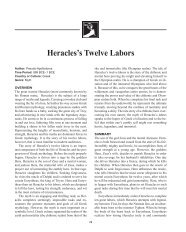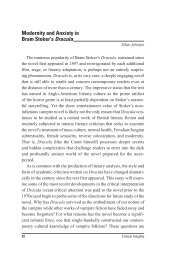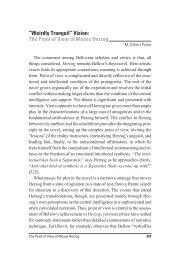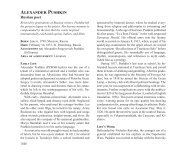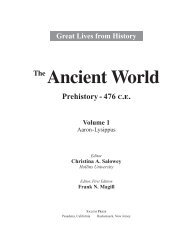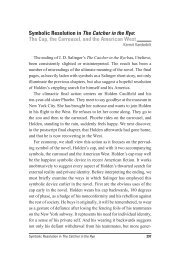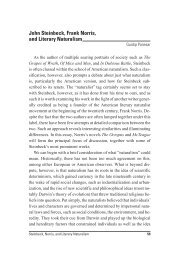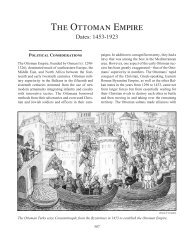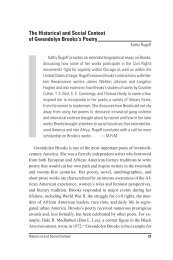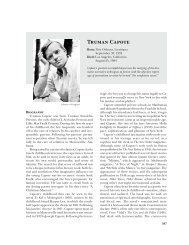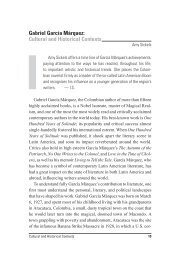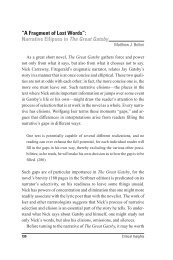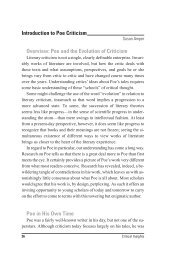You also want an ePaper? Increase the reach of your titles
YUMPU automatically turns print PDFs into web optimized ePapers that Google loves.
Critical Survey of Poetry Neihardt, John G.<br />
can Indian wars. It consists of five songs composed over<br />
twenty-nine years and totaling more than sixteen thousand<br />
lines. The five songs merge in a unified work<br />
around a central theme: the conflict over the Missouri<br />
River Valley from 1822 to the 1890 Battle of Wounded<br />
Knee, which marks the end of Sioux resistance.<br />
Neihardt chose the heroic couplet to help underscore<br />
his topic’s universal significance. He also modeled his<br />
poetry after other heroic epics, noting in The River and I<br />
that the story of the American fur traders had such literary<br />
potential, it made the Trojan War look like a Punch<br />
and Judy show.<br />
The Song of Three Friends, though composed second,<br />
begins the cycle with Will Carpenter, Mike Fink,<br />
and Frank Talbeau starting up the Missouri River in<br />
1822 with a beaver-trapping expedition. These comrades<br />
end up destroying one another’s potential over what<br />
starts as a rivalry for a chief’s half-breed daughter. The<br />
descriptive passages are powerful because, as Neihardt<br />
notes in his 1948 introduction, “If I write of hot-winds<br />
and grasshoppers, of prairie fires and blizzards, ...of<br />
brooding heat and thunderstorms in vast lands, I knew<br />
them early.”<br />
The second book of the cycle is The Song of Hugh<br />
Glass, based on the historical trek of an old trapper who<br />
survives because he knows the ways of the wilderness.<br />
Left to die by the others after being mauled by a grizzly,<br />
Glass is filled with a desire for revenge. He crawls for<br />
miles, endures starvation, thirst, near drowning, and<br />
freezing to track his betrayers. However, instead of a<br />
brutal revenge, he chooses to nobly forgive. Much like<br />
the Ancient Mariner, Glass is brought back to his better<br />
self by the vision of a ghostly brother:<br />
Stripped of his clothes, Hugh let his body drink<br />
At every thirsting pore. Through trunk and limb<br />
The elemental blessing solaced him;<br />
The Song of Jed Smith, though last to be completed,<br />
presents the third song of the cycle. This story is told by<br />
three first-person narrators, all trapper friends of Smith.<br />
Also, while the first two songs center on the larger-thanlife,<br />
but brutish, figures of Mike Fink and Hugh Glass,<br />
Jed Smith represents a more perfect flowering of the frontiersman.<br />
He is an awe-inspiring hero, a frontier saint,<br />
finding water in the desert, trail-blazing the unknown.<br />
The Song of the Indian Wars begins in 1865 with the<br />
period of migration; it focuses on the last great contest<br />
for the bison lands between the Plains Indians and the<br />
superior technology of the invading white race. The<br />
Sioux cannot understand the white people’s lust for land<br />
and gold, for their faith assumes a sacred unity with the<br />
earth and its resources.<br />
Since Neihardt intended his cycle to show a progress<br />
in spirit, in this song he turns from the mere indomitable<br />
physical prowess celebrated in the earlier songs to the<br />
spiritual triumph of the Sioux, even in the midst of their<br />
defeat. After his victory at the Battle of the Little Bighorn,<br />
Crazy Horse is hounded into starvation and surrender.<br />
The last section of this song, “The Death of Crazy<br />
Horse,” was Neihardt’s most popular work and was<br />
most often requested at his recitations. Here the landscape<br />
and animals reflect the agony of the tragic hero as<br />
Crazy Horse surrenders for the sake of his people. He<br />
loosed the bonnet from his head<br />
And cast it down. “I come for peace,” he said;<br />
“Now let my people eat.” And that was all.<br />
The last moments of the brave young man are dignified<br />
and noble, his language simple and straightforward.<br />
The Song of the Messiah, the fifth and last song of<br />
the cycle, records the conquered people, whose time for<br />
heroic deeds is over. The beavers, the buffalo, and the<br />
mighty hunters are gone; all that remains of these native<br />
people is their spirit. Although the whites appear to have<br />
mastered the continent, the poet indicates that he still<br />
needs to attend to his spiritual self if he is to be whole.<br />
The reduced Sioux people turn to the Ghost Dance<br />
religion, which offers nonviolence and a mystical link to<br />
ancestors, but this desire for rebirth is doomed; the song<br />
ends with the massacre at Wounded Knee. As the leader<br />
Sitanka dies, he has a vision of the soldier who smashes<br />
his skull:<br />
. . . And he knew<br />
The shining face, unutterably dear!<br />
All tenderness, it hovered, bending near,<br />
. . . . . . . . . . . . . .<br />
...Hestrove to rise in vain,<br />
To cry “My brother!”<br />
And the shattered brain<br />
Went out.<br />
2747



